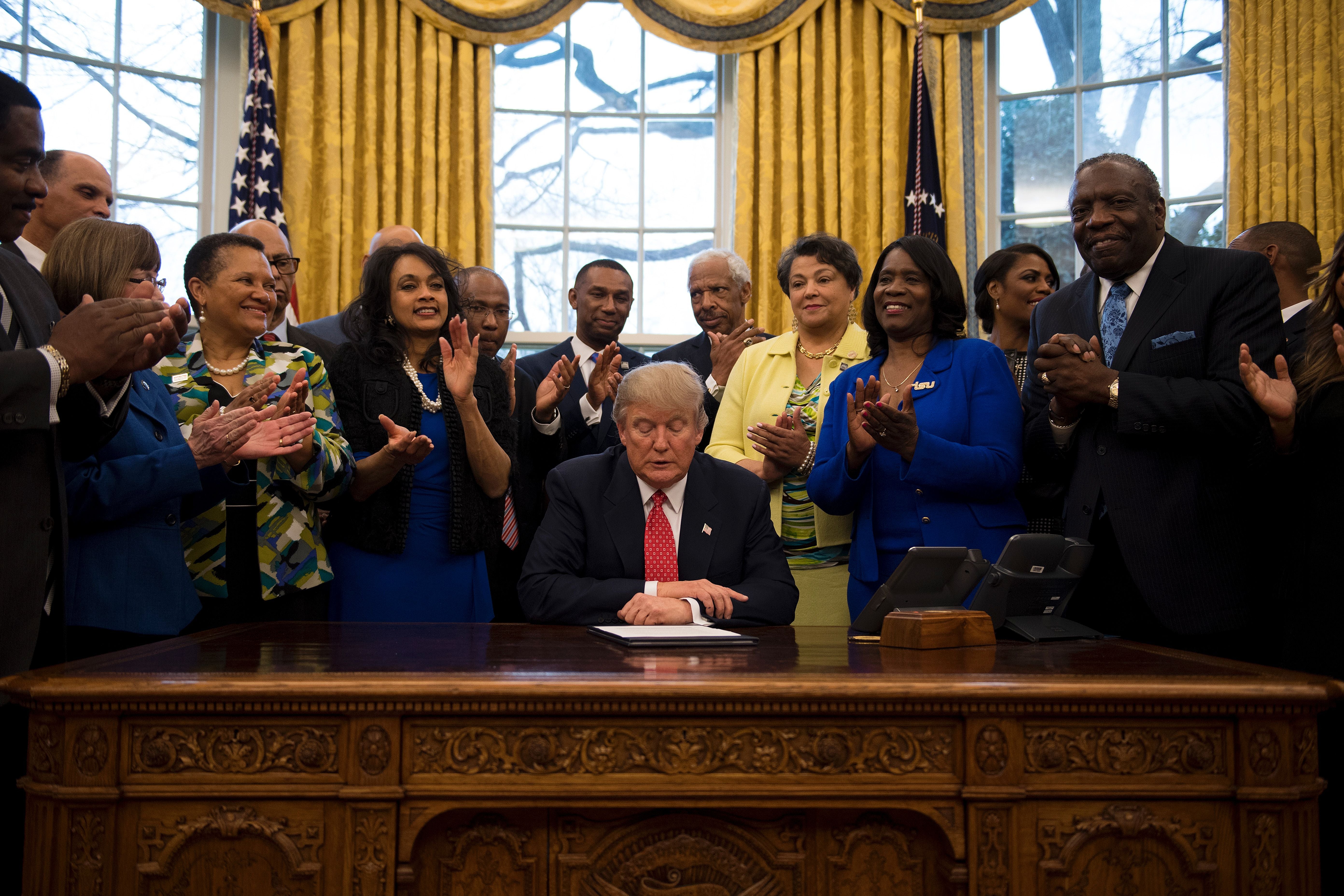
Dr. Juliette Bell grew up in rural Alabama, becoming the first in her family to attend college. Her dreams, drive and intellect led to a doctorate in chemistry, and a career in higher education.
Today, Bell serves as president of the University of Maryland Eastern Shore (UMES), one of more than 100 Historically Black Colleges and Universities (HBCUs) in 19 states, Washington, D.C. and the U.S. Virgin Islands.
]This week, she was among the ‘sista presidents’ who joined more than 80 fellow HBCU leaders in the nation’s capital. The presidents and chancellors spent two whirlwind days meeting with President Donald Trump, his cabinet and select members of Congress—with a goal of celebrating and strengthening HBCUs.
“I am hopeful,” said Bell. “We’ve heard what seems to be sincere interest in helping our HBCUs make even greater progress.”
On Monday, the HBCU leaders met with Vice President Mike Pence and Secretary of Education, Betsy DeVos, for a listening session. Controversy ensued after the Trump appointee referred to HBCUs as “real pioneers” of school choice, when the institutions were intended to educate Black students who had limited options due to segregation.
Representatives from HUD and other federal agencies were on hand as the group discussed ways they could improve education, enhance school infrastructure, and tackle policy issues impacting their campuses, many of which were founded during Reconstruction.
Subscribe to our daily newsletter for the latest in hair, beauty, style and celebrity news.
Later, the educators—escorted by White House aide and HBCU alumna, Omarosa Manigault, who’s been advocating for the schools—made their way to the Oval Office, where they were invited to pose for a group photo with the Commander-in-Chief.
“It’s not often that you have so many HBCU presidents all gathered under one roof,” said Eugene L. Anderson, Ph.D. of the Association of Public and Land-grant Universities (APLU) which represents dozens of HBCUs. “In many ways, it was a historic occasion.”
On Tuesday, Trump signed an Executive Order, pledging to do more for HBCUs than any other president has done before. A key component of the measure is that it re-establishes the White House Initiative on Historically Black Colleges and Universities (HBCUs), originally created in 1980 by then-President Jimmy Carter.
While presidents Barack Obama, George W. Bush and Bill Clinton all had HBCU initiatives, they were under the auspices of the U.S. Department of Education, which has faced major criticisms for red tape that affected the ability of minority students and their parents to secure loans. Trump’s new order returns the program to the White House.
It also creates an executive director who would report to the president, work in tandem with government agencies, and engage the private sector to leverage HBCUs’ unique capabilities. Moreover, government agencies would be required to create plans that “strengthen the capacity of HBCUs to participate in applicable federal programs and initiatives.”
“When you’re removing several layers of bureaucracy, those things can make a difference,” said Richard Gallot, Jr., an attorney and former Louisiana state lawmaker who was named the president of Grambling State University in 2016. “And when an agency or someone receives something from the White House, it suggests urgency and attention.”
The HBCU presidents garnered plenty of attention on Capitol Hill. On Tuesday, the group was welcomed to a day-long HBCU “Fly In” conference at the Library of Congress.
Hosted by Rep. Mark Walker (R-NC.) and Sen. Tim Scott (R-SC), the forum drew everyone from business executives, to House Speaker, Paul Ryan for a Facebook Live conversation. Congresswomen Mia Love (R-OH) and Alma Adams (D-NC), the founder/co-chair of the Bipartisan HBCU Caucus, were also part of program sessions.
One topic of discussion: HBCUs are drawing a more diverse demographic. While the more than 300,000 students currently enrolled at HBCUs are mostly Black, that’s not always the case. “Lincoln University in Missouri has a predominately White student body,” said Johnny Taylor, president of the Thurgood Marshall College Fund, which provides assistance to 40-plus publicly supported HBCUs.
Still, data shows nearly one in four African Americans with a bachelor’s degree graduated from an HBCU. Famed alumni include novelist Toni Morrison to Martin Luther King, Jr., Taraji B. Henson and Spike Lee. And 40 percent of African American members of Congress, graduated from HBCUs.
Given their history and relevance, the presidents stressed that funding remains critical. Federal dollars for HBCUS have grown, with some $4 billion allotted collectively in recent years, but advocates are hoping the Trump administration will further boost investment.
“The president has set a high bar; however, we await the opportunity to see if the administration will meet their pledges, specifically as it pertains to funding for HBCUs,” said Dr. Michael L. Lomax, president/CEO of the United Negro College Fund (UNCF).
“We must continue to work with the administration and with Congress to ensure that these historic institutions get both the recognition and the additional resources they deserve,” said Lomax, who was present for the ceremonial signing of Trump’s executive order.
For many of the presidents, the overall feeling was one of cautious optimism.
“I would characterize it as a start,” said Dr. Roslyn Artis, president of Florida Memorial University. “We’ve had the opportunity to educate the White House and the Legislative branch about the importance of HBCUs and the need to sustain them financially,” she said.
“In our case, 84 percent of my students are eligible for Pell grants, they’re low wealth. And for many first generation students, that money makes all the difference in terms of dropping out, or staying in school and graduating. We want them to succeed.”